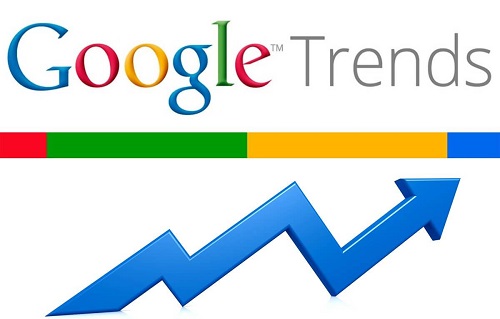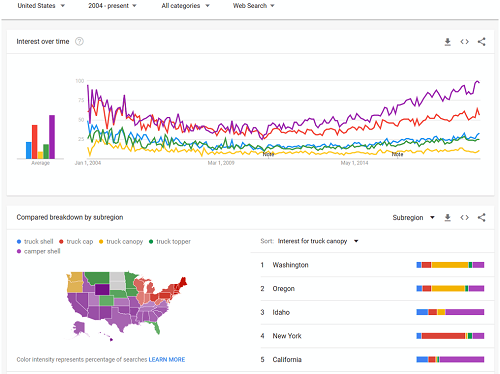Google Trends – What It Is, How it Works and Why it’s Useful
Google Trends is an extension of Google that analyses the popularity of search terms and top search queries in Google. It can produce results in a variety of languages, time periods, from different entities, and on a multitude of topics and themes.
In addition to just analyzing the popularity of search terms, Google Trends also offers useful insight about the searched term. This includes demographic information, as well as indications on whether the search term is on the rise or if it’s in fact losing popularity.
On average, Google processes 50 000 searches every second, and roughly 3.5 billion searches every day. Out of that tally, around 15- 20% are new searches. With all this data, Google is able to discover trends quickly, which makes it a powerful tool in this regard.
We are happy to have captured your attention up until this point. Continue reading this guide for more fascinating information about Google Trends and why it’s useful to webmasters.

The Uses of Google Trends in SEO?
Ultimately, this is a tool that you can use to conduct keyword research in SEO. And, while there are many other keyword tools that you can use, no other tool seems to provide the kind of insight that Google Trends does. Our research is founded on the free version of Google Trends which obviously has limited features, but the features it offers are still useful.
How to Conduct Keyword Research on Google Trends
So, how exactly do you use the tool for keyword research? Well, the first step is to search for a single term or phrase in the search box provided. You can search for one term, but also compare that term with the popularity of four other like terms. For example, if you are analyzing the popularity of the term Coca Cola, you can compare its popularity with terms that belong to the same theme or topics like Pepsi, Coke Light, Coke Zero and Coke No Sugar. Google is the default setting in Google Trends, but you can adjust the settings to produce search results from YouTube too. You can even filter your search to only produce image results, news results etc.
Once you’ve submitted the search, Google Trends will return a line graph (sometimes a bar graph too) indicating your search terms popularity over the last 12 months. Again, 12 months is the default setting. This can still be adjusted to the past hour, past 4 hours, past day, past seven days, past month, past 90 days, past 5 years or from 2004 to present. Alternatively, you can customize the entire result to a specific timeframe that you would like to look at.
However, we would suggest that you look at your search terms popularity over the past 3 or so years, as opposed to just over the past 12 months. This will give you a clearer indication of whether your search query is truly a trend, or simply just a current obsession. The real trick is to identify and use keywords that have been a consistent trend over the years, perhaps even one that’s been growing in popularity. Avoid keywords that show a decline in popularity.
Using Google Trends to Find Related Keywords and Topics
In addition to comparing the popularity for core search terms, you can also find queries and topics closely related to your search term that’s also growing in popularity. This function is great because it gives you other good terms to potentially use in your copy.
To get the list of related queries or topics, you simply type in your core search term and the tool will provide a drop-down list of related phrases. You can click on any of those related phrases for more information. All terms are listed in order of popularity and Google Trends even gives you the search popularity of each in percentage.

Differentiating Between Google Trends and Breakout Keywords
Of the related search terms and topics given to you, you might realize that instead of a popularity percentage, some may show the word “breakout”. This means that that specific keyword has robustly increased in popularity by over 5000% over the period you are looking at. It also means that little to no interest was shown in that specific keyword until something happened in your region of search for that spike to occur.
Now, you have to be careful about how and when you use breakout terms. On the one hand, breakout terms on Google Trends can be very beneficial to use since they’ve started to gain traction. However, they have not yet been established as a competitive keyword. This means that when you hop on the trend soon enough and produce content about it, you could possibly land yourself the number one spot on SERPs even before the keyword becomes mainstream.
On the other hand, though, building your entire strategy on breakout keywords could quickly become a fail if those keywords are simply fads, i.e. popular for the moment, and not real trends. So, it is likely that the content you produce from breakout keywords will eventually go stale. And, if your goal is to produce evergreen content then this might not be the way to go. It could work great for short, newsy blogs that are generally time-bound.
Seasonal Trends and Promoting Content When the Time is Right
A trend speaks on the popularity of a keyword, phrase or event within a region over a period of time. But sometimes the popularity of events or keywords is seasonal which means it spikes most during certain periods and dies down in others. You should know that the popularity of keywords can be affected by Google trends too.

Imagine for a second that you own an online store. To an extent, your business is season dependent. Is it not likely that during the summer period clothing terms like affordable bikini’s, beach towels, dresses, shirts, shorts and shades may dominate search queries on your website? Similarly, over the wintertime, queries like jackets, sweaters, hoodie’s socks, blankets and gloves are likely to be most popular. Your job then is to determine when your seasonal peaks and lows are. A task for which Google Trends is made for. Then, with the data you collect, you can do one of two things:
- Write content to coincide with the peak: For example, if you live in the USA and you have a sports betting website, it might be a good idea to write up your main NBA sports betting page(s) and publish it when the league starts. If we consider the current NBA season timeframe, you would have written and published the page(s) in Dec 2020, in time for the 2020-2021 season currently underway.
- Optimize existing pages well ahead of the peak: Let’s say you already have an NBA guide, it would be best to start optimizing such pages a couple of months before the peak starts. One way of optimizing those web pages would be to create a link building strategy around it. This way you ensure that most of your NBA pages link to each other. This could result in a spike in traffic to your site, or NBA page when the season starts. It might not be tons of traffic, but in a business as competitive as this, all positive traffic is welcome.
Google Trends and SEO Overview
Congratulations on making it this far, you’ve successfully reached the end of the article. On a serious note, though, we hope the information provided was useful and that you’ll use Google Trends the next time you are in search of fully targeted keywords to use in your content. Feel free to engage with us by leaving a comment, or share some of your knowledge on the tool with us.
See Other Posts
- Importance of Sitemap for SEO, April 21, 2021
- How to Use Reddit to Improve Your SEO Performance, April 16, 2021
- High Ranking Articles: What Sets Them Apart, March 26, 2021
- How Do I Write a Meta Description for SEO?
- The importance of a Website Source Code


